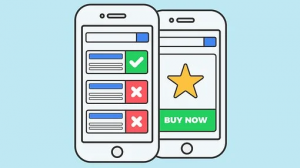In May 2010 Matt Cutts of Google released a video explaining that metrics such as Facebook ‘likes’ and Twitter followers, which indicate a profile’s influence, do not affect search rankings. This was disheartening news as the infographic below shows, 74% of companies and 82% of marketing agencies use social media as either a main or secondary component in their SEO strategy. In December of 2010, Cutts said that the algorithm does use social signals in search results. And then, in January 2014, Cutts withdrew his statement and said that they do not.
So, where does that leave us?
Well, Neil Patel, SEO expert and founder of Quicksprout, urges people not to ignore social media. (He believes that social is the new SEO.) Social media engagement provides Google with external validation of a page’s effectiveness and popularity. This means that social media marketing and SEO work in tandem: what works well for one works for the other. So, let’s review five steps to help make social media work for your SEO.
- Create Link Opportunities
One of the best opportunities for social media to help boost SEO is passive: it depends entirely on participation from a third party. Simply put, it’s using social media to promote your content. People can’t and won’t link to something they don’t know about. Social media is an important and effective way to let content creators know that your material/website/profile is link-worthy. Here’s a few tips to help you get started:
- Create a strategy for the social promotion of your content. Include where, when and how you share it, according to the type of content you create
- Make a list of the best evergreen content and schedule it to be re-shared regularly. Remember that individual posts are only seen by a small portion of your potential social media audience, repetition is valuable
- Build a valuable target audience that will increase your earned-link opportunities.
- Increase Positive Brand Mentions
The purpose of a social network, even for business, is sharing. ‘Likes’, comments, and ‘shares’ are the most helpful actions for SEO: the more your followers share your content, the more opportunity for SEO visibility. You want your social media posts to appear beyond social media including blog posts, articles, slideshow presentations, e-books, etc…So, make it easy for people to engage with your content. If a particular brand, largely unnoticed by Google, starts getting a lot of online endorsement, it could cause Google to view them as an “entity” that deserves more attention.
There might be search engine queries that you don’t rank for but the more positive online mentions you get, the more likely it is that Google will realize people see you as relevant for the queries you do show up in. It’s not how high you rank in a search, it’s what you rank for. So, do what you can to increase your followers’ urge to make positive mentions of your brand on social media and other places like forums:
- Build your personal brand: mention your business name in other contexts I.E: a personal blog, guest blogs, offline mentions…
- Continue to put effort into building a targeted audience on social media
- Give positive reinforcement to followers who mention your brand online
- Ask provocative questions to get people talking about your brand
- Use quality, unique hashtags to enter your content in larger online conversations
- Format tweets to they’re easy to re-tweet
- Speak at events and increase your brand mentions via attendees who tweet, bog and cover the event on their social platform.
- Guest blog and interact on forums
- Never stop adding high-quality content to your social media platforms
- Build Partnerships
Use social media to build strategic relationships that will lead to potential online- brand partnerships. It’s increasingly difficult to reach an audience organically on social media because of the constant rise in usage and therefore competing content. This means marketers should concentrate on the thing social media was designed to do: connect and relate. Here are three examples of relationship-building:
- Brand fans are active social media users who adore your brand. They are unpaid supporters who multiply your effectiveness for free
- Organic influencers are different from paid influencers, which is what most brands mean when they refer to ‘influencer marketing’. Organic influencers have genuine expertise, authority, and trustworthiness. (Google’s famous E-A-T formula). They are valuable to your brand because their shared, positive endorsement about you or your products/services will be taken seriously by their audiences
- Strategic partners are non-competitive businesses or influential people in your industry with whom you can co-create valuable content that leverage both of your social platforms
Your goal is to build real relationships with your top followers, organic influencers and potential partners. To do this you will have to go beyond robo-liking posts: answer questions and provide useful advice, comment on their projects and share valuable relevant content. Make a list of the accounts you most want to connect with and make sure that each of those gets regular attention.
- Create Live Video
Marketing analysts Cicso predicts that video will represent 82 percent of internet traffic by 2021. In fact, 80% of consumers currently want more live-video content from the brands they follow. It’s no surprise then, that Facebook deliberately boosts “live” content in their feed. With social media platforms consistently making it harder to show up in SERPs, live video is one way that still works. That means that brands have to learn how to engage their followers with exciting and unique live-streams in order for the results to benefit their SEO. Here are some things to consider when approaching live-video content.
Focus on the Right Social Media Platforms
Certain platforms are better for brands. The right social network will ‘make or break’ your live video’s success from both a social and an organic perspective. Select networks where you already have attentive followers and the confidence to create and strategically post high-quality live-stream video. For SEO, this means choosing the qualified networks that let you add links to the post and make it easy to annotate your videos. The best networks for social media attention and SEO are YouTube Live and Facebook Live. Instagram Live disappears after 24 hours, Meerkat doesn’t offer replay and Twitch is only relevant if you’re in the gaming industry.
With Facebook Live you can create a permanent post, download your video and embed it on your own site, add a description and review analytics during and after your stream. YouTube Live offers the same features and, Google owns it.
Follow Best Practices
Pre-scheduling posts will encourage followers to watch the live stream while it’s happening (not a replay) and using the same hashtag in all your posts will help create recognition and a sense of ‘buzz’. During the video, engage with viewers via questions and responses and invite them to tag Facebook friends in the comments section (live stream comments are included in Facebook’s live video ranking algorithm). Encourage people to visit your website with a clear, easy URL. Keep the URL visible throughout the video by writing it in big letters on a whiteboard behind you, making a big poster or designing a special t-shirt: whatever it is, keep it visual for the people who watch with the mute ‘on’.
Gain Momentum After You Publish
Once you finish live streaming, publish the video to your page and follow all the steps on your SEO checklist for regular video. This means adding a keyword-optimized title and tags and a summary of takeaways, exporting the video to other social networks, blogs and landing pages and making an embed code that links back to your website. Before you post your video to every social platform possible, make sure it’s high-quality and professional by downloading and using a video-editing app like Instasize that will help you adjust duration, colour and lighting.
- Measure and Optimize
Something that can be measured can be improved. Get the most from your social media efforts by regularly monitoring and adjusting your strategies. There are numerous metrics you can use to measure the impact social media is having on your SEO ranking. Pay attention to comments, shares, and brand mentions. Higher numbers mean more relevance and authority, two major factors in search rankings. Watch how social media impacts your website: visibility levels in SERPs, traffic associated with it and conversion rates. If you know what is or it isn’t working for you, you can you modify and hone your social media efforts.
Social media works a lot like the search engines. So, it’s essential that you create posts that are optimized for both your SEO and your target audience. In addition, optimizing your social media profiles will also benefit your rankings. While these may seem like minor details in the grand scheme of SEO, they add up to make a significant difference.







